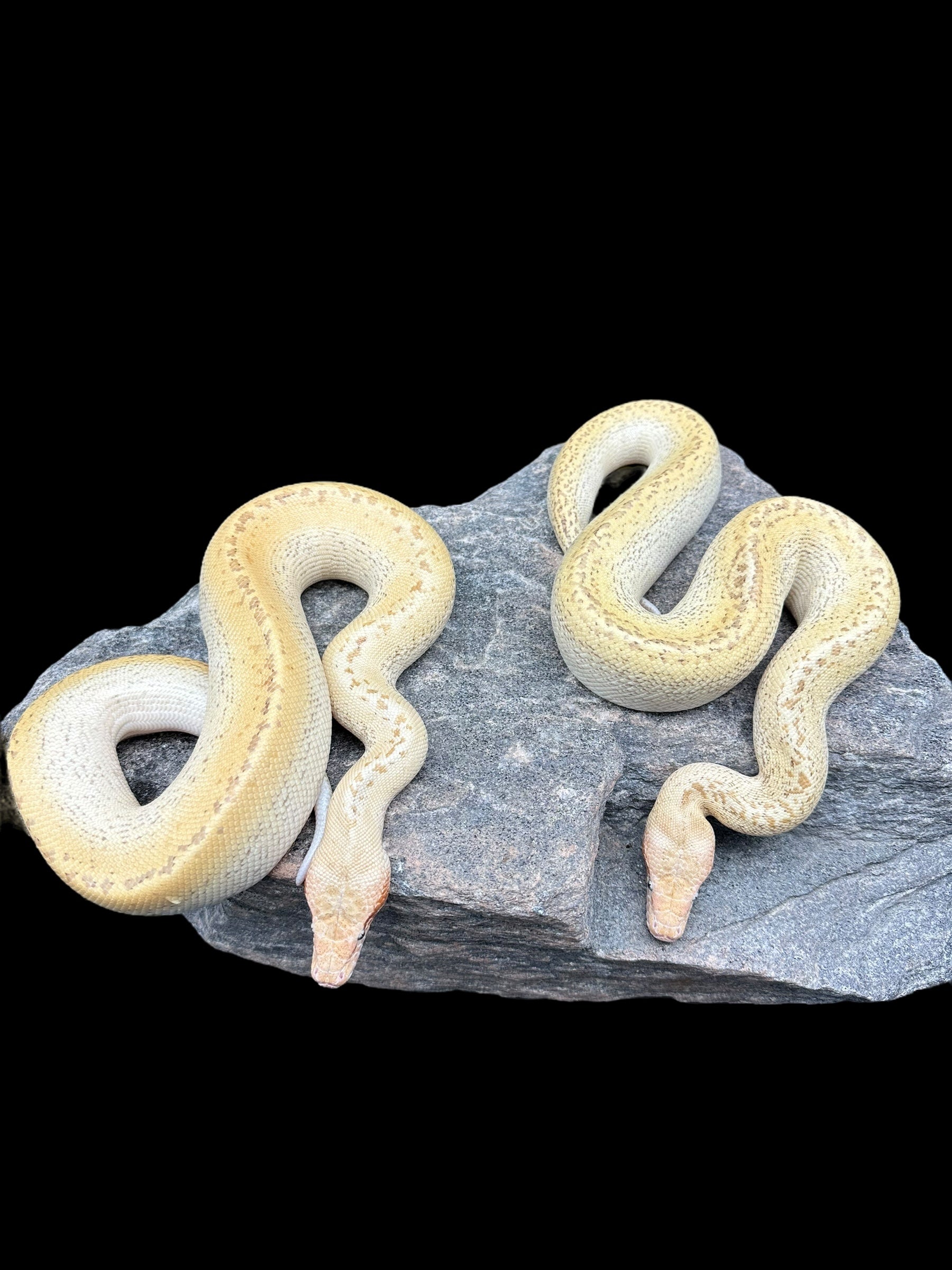Photo Disclaimer
Description
Blood Python (Electrostatic – T+ Albino Ivory Batik)
Python brongersmai
Common Names: Blood Python, Brongersmai Python
(Electrostatic = combo morph name; T+ Albino = recessive morph; Ivory = super form of Matrix; Batik = co-dominant morph)
Species Overview
-
Size: Adults typically grow 4–6 feet (1.2–1.8 m), with females usually bulkier. Some exceptionally large animals may exceed 7 feet.
-
Appearance:
-
Batik (co-dominant – visual): Produces a maze-like, pixelated pattern across the body, with light striping on the head.
-
Matrix (co-dominant – super form = Ivory): The Ivory is the homozygous form of Matrix, producing a pale, almost patternless appearance with a smooth cream or ivory tone.
-
T+ Albino (recessive – visual): Removes melanin while leaving caramel, golden, and chocolate tones intact, softening the contrast into warm pastel shades.
-
Electrostatic (named combo): A designer morph combining T+ Albino + Ivory (Matrix Super) + Batik, producing a stunning snake with a soft golden-ivory base, reduced Batik pixelation, and ghostly caramel highlights.
-
The result is one of the most unique and high-contrast T+ Albino combos in Blood Pythons, with a glowing, “static-like” appearance.
-
-
Distribution: Native to Peninsular Malaysia, Sumatra, and surrounding islands.
-
Habitat: Typically found in swamps, marshes, and humid forested areas, preferring environments with dense cover and moisture.
-
Behaviour: A terrestrial ambush predator, heavily bodied and reliant on stealth, feeding on small mammals and birds.
Captive Care
-
Enclosure: Adults require at least a 4 ft × 2 ft × 1.5–2 ft enclosure, prioritizing floor space. Provide a snug hide, deep humidity-holding substrate, and a large water bowl for soaking.
-
Temperature & Humidity: Keep a basking area at 86–88°F (30–31°C) and a cooler side at 78–80°F (25–27°C). Maintain humidity at 60–70%, with spikes to 80% during shed cycles.
-
Diet: Juveniles feed well on hopper rats or equivalent prey every 5–7 days; adults typically eat medium to large rats every 10–14 days. Avoid overfeeding, as Blood Pythons can become obese.
-
Behaviour in Captivity: Captive-bred Electrostatics are generally hardy and thrive in captivity, though like many Blood Pythons, they can be food-motivated and defensive if startled. With consistent husbandry, they often become steady captives.
-
Special Considerations: These snakes benefit from naturalistic setups with deep substrate and stable humidity, which support their health and natural behaviours.
Genetics Note
-
Batik (Co-Dominant – Visual): Produces a shattered, maze-like pattern.
-
Matrix (Co-Dominant – Super = Ivory): When homozygous, creates the Ivory, a reduced-pattern, pale cream morph.
-
T+ Albino (Recessive – Visual): Expressed here, producing caramel and golden hues instead of black.
-
Electrostatic (Combo Morph): A named designer combination of T+ Albino + Ivory (Matrix Super) + Batik, resulting in an ivory-golden, reduced-pattern snake with ghostly pixelation.
The Blood Python (Electrostatic – T+ Albino Ivory Batik) is one of the most visually spectacular and genetically powerful combos in the Blood Python hobby, combining three influential morphs into a glowing, caramel-ivory phenotype with immense breeding potential.

